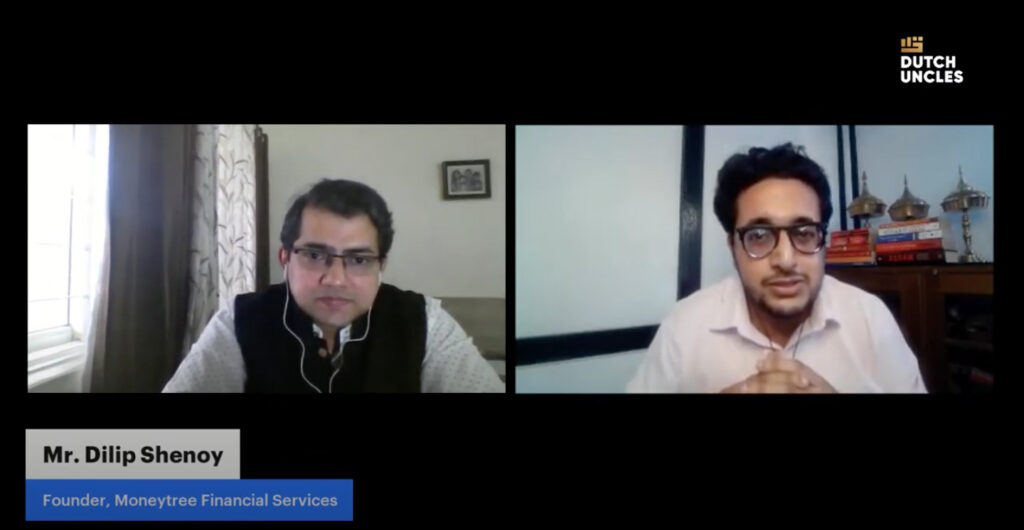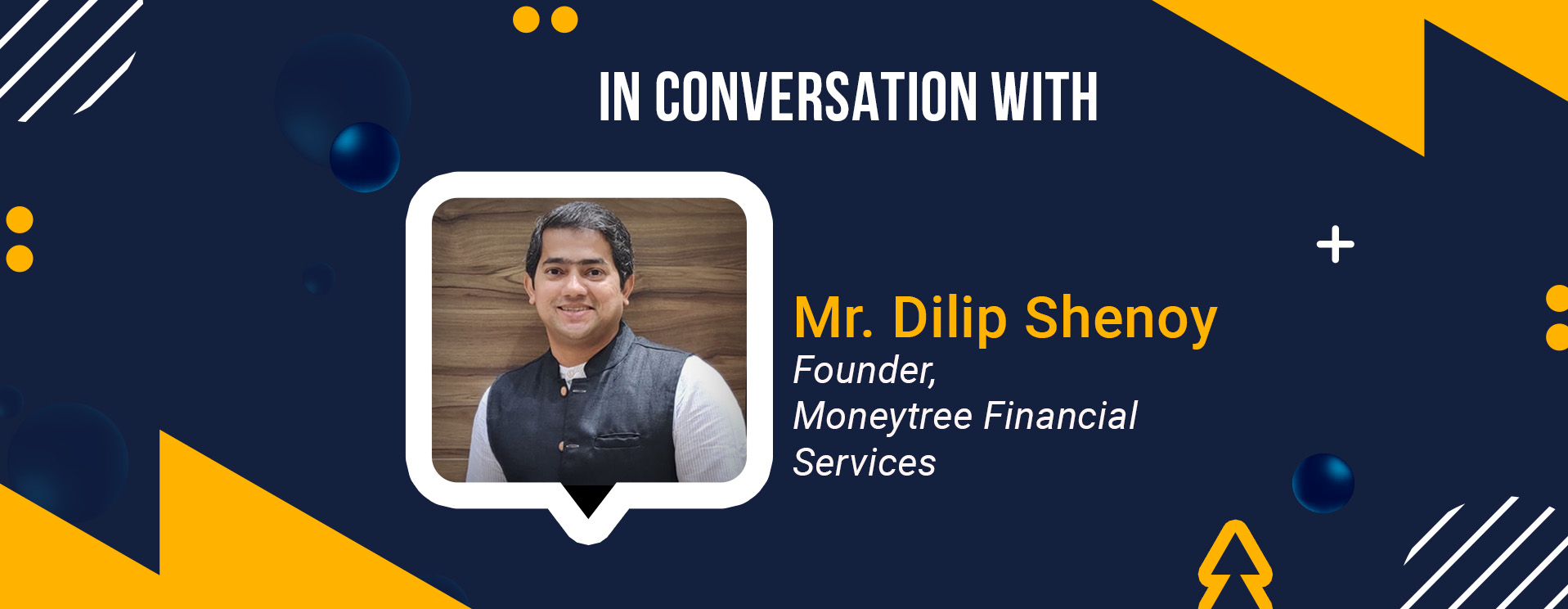If you desire a secured future, it is in your hands entirely how you set a financial goal in mind. But again, without clarity, you might end up with a complicated, risky and ill-planned strategy. Creating a successful ‘wealth creation’ journey and ruling out the unpredictability by having a goal-based investment plan, is the key to a successful wealth creation path.
In the recent episode of MentorED – a LIVE Workshop Series by Dutch Uncles – the esteemed speaker, Mr. Dilip Shenoy enlightened the audience – who joined LIVE across four platforms – LinkedIn, YouTube, Facebook and Twitter – about the important steps of goal-based investing and ways to have a risk-free and safe wealth creation journey. Mr. Dilip Shenoy is the Founder of Moneytree Financial Services and has more than two decades of experience as a Financial Coach specialising in the wealth management and banking industry. With a vision of simplifying financial aspects of life, he extends support and guidance in the wealth management sector.
In brief, the session had the following takeaways:
- Understand your financial self
- The various cycles: age cycle, wealth, growth, recession, rate, economy and the cycle of credit
- Risk mitigation
- Projecting the road ahead
‘‘
Fulfill the nearer and easier goals first, it's easier to do that. But start early for the long term.
-Mr. Dilip Shenoy
Wealth Creation Journey: A Six Step Process
Everyone across age, borders, caste, creed, sex, likes to travel, meet new people, witness various cultures, experience food, weather, etc. When we travel we decide on a destination, then the mode of transportation as per our convenience and personal preferences. Similarly, an investment journey is like planning a vacation, one has to know all the parameters and evaluate different aspects before setting foot into this sector. It is very important to plan your investment in detail. Wealth creation journey or wealth management is a six step process, namely: (1) Knowing oneself, (2) Investing time before investing money, (3) Identifying goals, (4) Evaluating options, (5) Selecting a vehicle, and (6) Periodic Maintenance.
“You need to know yourself.” As the speaker mentioned, in wealth management parlance, there are usually three cycles, human life cycle, wealth cycle and the credit cycle. If human life cycle and wealth cycle are superimposed, then they are: early career or saving stage (between 25-30 years), wealth creation stage (30-40 years), wealth accumulation stage (40-60 years) and wealth distribution and succession planning stage (50-60 years).
The wealth cycle is typically dependent on wealth creation and savings. In order to understand your own self, it is important to prepare a risk profiling questionnaire, which will help you to evaluate your knowledge about the financial product and categorise yourself whether as a conservative, moderate or aggressive investor. Most importantly, distinguishing between your needs and wants will give you a profound understanding of yourself. Time is of paramount significance here as advised by Mr. Shenoy who asked to first invest your time before money. “Start with a budgeting exercise, whatever gets measured gets treasured, like a wise person had put it earlier.” Moreover, it is wise to always evaluate the alternatives as unlike the yesteryears when there used to be only limited options to choose from. But amidst all the information, making a smart and cautious decision is the key.
In the goal identification step, it gets very challenging to look beyond the long term horizon, so one should categorise it into short, medium and long term. After identifying these goals you need to calculate the approximate values that you will be needing. Mr. Shenoy advised, “Fulfill the nearer and easier goals first, it’s easier to do that. But start early for the long term.” In all these comes the power of compounding, the 8th wonder, which will eventually help an investor to fulfill their long term goals. With the new products in the market coming each day, it makes our tasks more challenging to find the right financial product. “First and foremost, whenever you decide to invest, be clear in your mind whether you are looking at a wealth preservation objective or a wealth creation objective. There is no other third objective in my opinion.”
As far as selecting the right vehicle is concerned, always look for your own comfort level. Get a right time frame for your investments so that you do not regret the lost opportunities. Be patient and stay focused on real returns and never ever get swayed away by the luring market values. Instead be patient, as the journey of wealth creation needs persistence and determination. Last but not the least, drawing the analogy of a road trip throughout, the mentor underlined the relevance of periodic checks. Similarly, your investments and your portfolio needs to have a periodic review. Get this review done by a financial coach, or an advisor to get a third party perspective. Monitor and rebalance your portfolio and avoid over-information.
‘‘
First and foremost, whenever you decide to invest, be clear in your mind whether you are looking at a wealth preservation objective or a wealth creation objective. There is no other third objective in my opinion.
-Mr. Dilip Shenoy
Audience Asks
There is always a dilemma regarding the duration of my investments. I want to have some clarity on this.
What is important here is to try to map your investment vehicle to the time horizon. For example, my son is in the 10th standard and he has a higher education corpus outflow which will be coming in another 2-3 years’ time, so this time frame is very small to put your money in equity. So this rules out the equity option and you would want to park it into a fixed deposit or a bond fund. But if your time horizon is on the higher side, then drawing a timeline becomes essential and these are the major outflows. There cannot be one template that fits all, depending upon factors like your balance sheet, lifestyle.
There is so much information on the internet regarding investments, wealth management, financial needs, etc. and it is usually very confusing. How do you suggest that one can refine this information and make the most out of it?
I would explain it with something like cricket, everybody understands and follows cricket. So at the start of Sachin’s career he had a coach, Mr. Achrekar, who could probably guide him. Similarly, when you start playing in the investment world, it is best to have somebody as an expert, could be from family, a chartered accountant, an advisor, or a mutual fund distributor. There are a lot of products but not necessarily all these products will suit you. So avoid the noise, avoid the information overload, get an expert in the initial 5-10 years, get into simpler products that you understand, and get into a vehicle that you know how to drive and know how to fix.

Get ready to walk the journey
As Mr. Dilip Shenoy opined, finance is something like an ocean, you really need to dive through to experience it. It does not have any tangibles. The investment planning or products do not have any features so only when you burn your hands or walk the journey is when you realise the product potential.
Watch the entire episode on YouTube, LinkedIn, Twitter or Facebook to devise your goal based investment plan.




